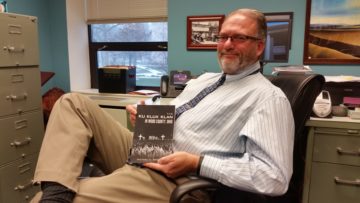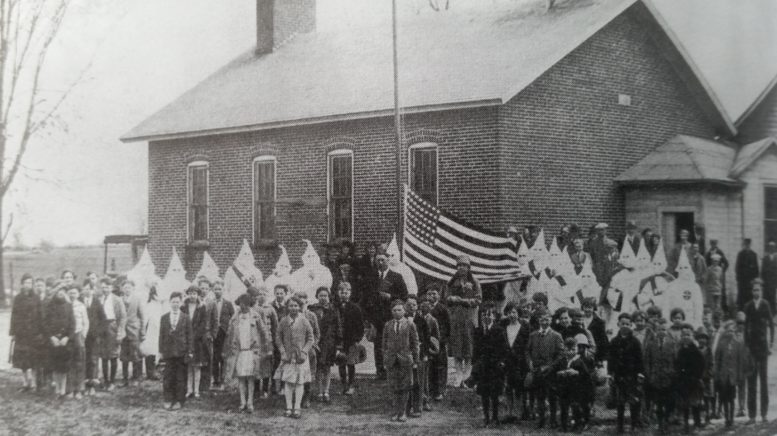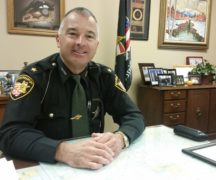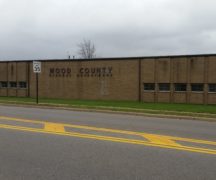By JAN LARSON McLAUGHLIN
BG Independent News
When the Ku Klux Klan took root in Wood County in the early 1920s, the members wore the traditional white robes and hoods, but there was little secrecy about their activities. There was no need to conceal their hatred since the membership roster included many local politicians, businessmen and ministers.
Every Ohio county in the 1920s had an active Klan group, according to Michael E. Brooks, author of the book, “The Ku Klux Klan in Wood County, Ohio.”
“Wood County is not particularly unique in having a history of the KKK,” said Brooks, a historian who teaches at BGSU. “What is unique is that the records survived.”
Included in those records is a membership ledger that was reportedly rescued from a burn pile in 1976. The ledger, which is included in Brooks’ book, reads like a “Who’s Who” of Wood County, with familiar surnames recorded from every community.
Brooks explains that economic uncertainty in the 1920s was one of the most significant factors in the rise of the reborn KKK in Ohio. Newspapers told of historically high unemployment rates, declining farm incomes and sluggish postwar economic growth.

Michael E. Brooks holds his book, “The Ku Klux Klan in Wood County, Ohio.”
Membership records in the Center for Archival Collections at BGSU show that nearly 1,400 members paid dues to the Wood County KKK in 1924 and 1925.
Once accepted into the Klan, the new members would be fitted for robes and hoods. Measurements would be taken at the local KKK office, and the information would be submitted to the national Klan headquarters for tailoring. No women or children were allowed.
A 1927 phone book lists the KKK as having an address at 182½ S. Main St. in Bowling Green.
“They didn’t have to sneak around at night. They could parade around in their robes,” Brooks said. “It was fashionable to be in the Klan.”
The Klan was welcomed into many local churches during Sunday morning services. Many of the local ministers were members of the organization, like Rev. Rush A. Powell of the United Brethren Church in Bowling Green. Powell, a charter member of the Klan, told his congregation that he stood for the same principles as those held by his hooded guests – against criminal activity, undesirable immigrants and a decline in morality.
Recruitment during church services was common. “The extent to which that was going on was very surprising,” Brooks said. Churches were used to add to the “moral legitimacy” of the group. According to records, nearly 40 percent of the Protestant clergy in Wood County were KKK members.
People with political ambitions also were not afraid to add the Klan to their resume. “It helped get people elected,” Brooks said.
In the 1920s and 1930s, Klan members in Wood County served as mayors, county commissioners, county sheriffs, county judges, county prosecutor, police officers, and village marshals. Also on the list of Klan members were school principals, superintendents and school board members.
The KKK used large outdoor open rallies as recruitment tools. The gatherings often included band music, food concessions and games.
Klan members, wearing their robes and hoods, would also make school visits. The prearranged visits often used ritual and ceremonial activities, with the Klan presenting gifts like flags and Bibles.
Klan chapters purchased athletic sweaters for local high school sports teams, possibly as a recruitment effort as the teens neared the age when they could join the Klan.
Though few incidents of crime were committed by the local Klan, the threat was implied. Cross burnings were frequently used to make a statement. “We know where you live. We are watching,” Brooks said.
“They were emboldened,” by mainstream acceptance of acts of intimidation, he said.
One cross burning was recorded in 1923 on public school grounds in Bloomdale after the performance of the operetta “Miss Cherry Blossom.” The plot involved an American girl living in Japan, whose parents died and she was raised by a Japanese family. “Evidently anti-Japanese sentiments among Klan members were sufficiently intense that this plotline offended their sensibilities,” Brooks wrote.
The Klan also burned a cross and set off an explosive device outside the Prairie Depot Church of Christ in 1923 after members of the church protested the Klan’s recruitment speaker during a Sunday service.
Much of Brooks’ book is based on the meticulous membership register maintained by the local Klan. The record books included dates of initiation, payment of dues and information on members’ banishment, departure or death. For example, the note in one margin explained the banishment of one member after he married a Catholic woman.
The KKK members felt no need to conceal their activities. The book tells of a recruitment rally in 1923 that drew between 15,000 and 20,000 people. A KKK parade with several marching bands and Klansmen on horses stretched more than a half mile. The burning of four huge crosses – with the largest reaching 40-feet – brought the event to a close.
Local newspapers in the 1920s expressed blatant racism and anti-immigrant opinions. Minstrel shows in Wood County were mainstream forms of entertainment, with white performers donning blackface to portray African Americans “as dimwitted buffoons or as morally bankrupt individuals deserving of mockery.”
“Minstrel shows were common place,” Brooks said.
Even into the 1930s, the local organization had no need to keep its activities secret. The group continued to operate out of a storefront on South Main Street in downtown Bowling Green. A chart in Brooks’ book shows the Klan membership for each municipality in the county. The highest percentages of membership were found in Portage, Rudolph, Prairie Depot (now Wayne), Weston, Cygnet, Bowling Green and Custar.
Since there were very few African Americans to target in Wood County, much of the hatred from the local KKK was directed at Catholics and immigrants from “undesirable” countries. The book tells of crosses burned near St. Aloysius Church in Bowling Green.
Local Klansmen were motivated by fear of immigrants from Germany, Ireland, southern and eastern Europe, Latin America, and any Muslims. Noticeably absent from the list of ministers in the Klan were German Lutherans, Brooks said. In the early 1920s, Germans were among those still considered as “outsiders.”
Members were recruited under the guise of joining a “patriotic” organization intended to preserve the “100 percent American” way of life. During a 1923 rally in Bowling Green, a Klan officer pushed for an immigration ban. “It will not be long before this melting pot will boil over if all immigration is not stopped,” he preached.
The local KKK had an “America first mentality,” and promoted the organization as patriotic.
Brooks referred to the Klan as the “Amway of Hate,” with an initiation fee of $10 which would be the equivalent of $100 today. “You had to really want to join this group.”
Brooks’ research found very little Klan activity on the campus of then Bowling Green Normal College. “That was a pocket of lessened Klan activity,” he said.
Though some may see a recurring theme in the current anti-immigration movement in the U.S., Brooks is hesitant to make comparisons.
“We kind of go through phases in U.S. history of being more or less accepting of outsiders,” he said.
As in other areas of the nation, the KKK in Wood County gradually lost its hold as public scandals rocked the organization and the economy improved. There appeared to be a few dozen hard-core members who continued to be active until the late 1930s.
Brooks, who grew up in Detroit and later lived in Toledo during the 2005 neo-Nazi riot there, started his research on the local KKK history to try to understand the why people hate.
“I was curious as to why people join these groups. It was an intellectual curiosity that had been bubbling a long time,” he said. “I think it’s a learned behavior. I don’t think we are hardwired to hate.”
Brooks is working on a second book on the history and current status of hate groups in Ohio. That book will be out in 2018.
The author is hoping readers gain an understanding of the lingering hatred left behind by groups like the KKK. “We should be aware of how everyday racism, nativism, anti-Semitism, and anti-Catholicism” still exist even if they are not as overt as in the past, he said.





